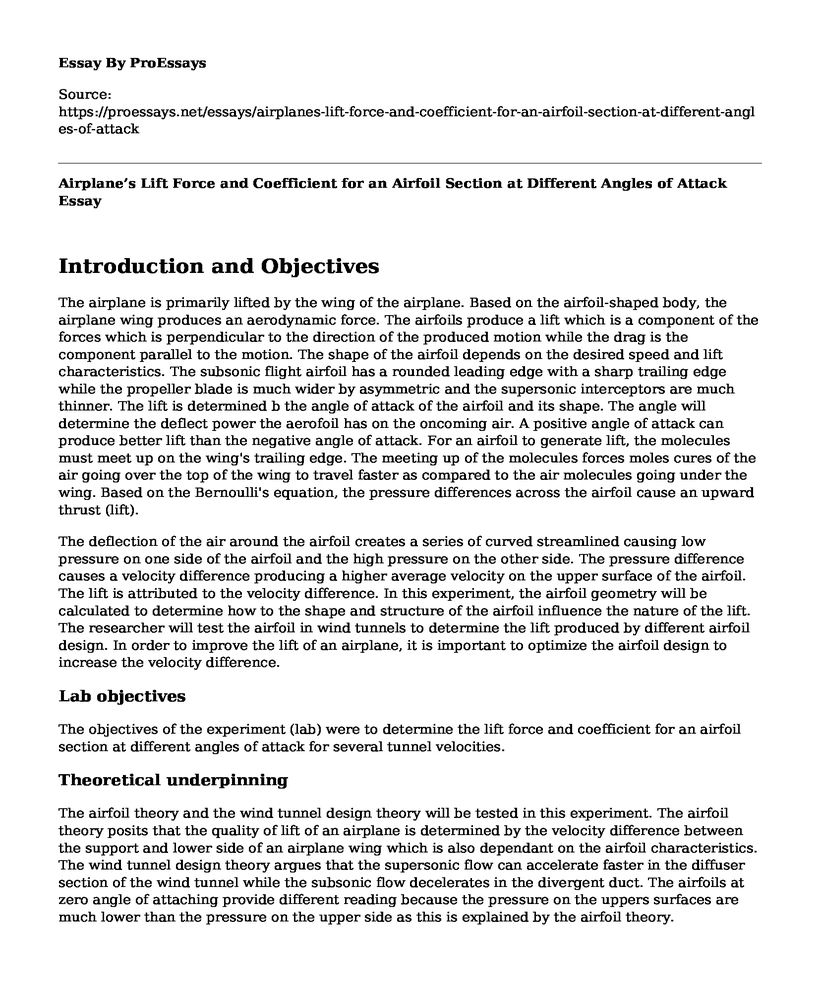Introduction and Objectives
The airplane is primarily lifted by the wing of the airplane. Based on the airfoil-shaped body, the airplane wing produces an aerodynamic force. The airfoils produce a lift which is a component of the forces which is perpendicular to the direction of the produced motion while the drag is the component parallel to the motion. The shape of the airfoil depends on the desired speed and lift characteristics. The subsonic flight airfoil has a rounded leading edge with a sharp trailing edge while the propeller blade is much wider by asymmetric and the supersonic interceptors are much thinner. The lift is determined b the angle of attack of the airfoil and its shape. The angle will determine the deflect power the aerofoil has on the oncoming air. A positive angle of attack can produce better lift than the negative angle of attack. For an airfoil to generate lift, the molecules must meet up on the wing's trailing edge. The meeting up of the molecules forces moles cures of the air going over the top of the wing to travel faster as compared to the air molecules going under the wing. Based on the Bernoulli's equation, the pressure differences across the airfoil cause an upward thrust (lift).
The deflection of the air around the airfoil creates a series of curved streamlined causing low pressure on one side of the airfoil and the high pressure on the other side. The pressure difference causes a velocity difference producing a higher average velocity on the upper surface of the airfoil. The lift is attributed to the velocity difference. In this experiment, the airfoil geometry will be calculated to determine how to the shape and structure of the airfoil influence the nature of the lift. The researcher will test the airfoil in wind tunnels to determine the lift produced by different airfoil design. In order to improve the lift of an airplane, it is important to optimize the airfoil design to increase the velocity difference.
Lab objectives
The objectives of the experiment (lab) were to determine the lift force and coefficient for an airfoil section at different angles of attack for several tunnel velocities.
Theoretical underpinning
The airfoil theory and the wind tunnel design theory will be tested in this experiment. The airfoil theory posits that the quality of lift of an airplane is determined by the velocity difference between the support and lower side of an airplane wing which is also dependant on the airfoil characteristics. The wind tunnel design theory argues that the supersonic flow can accelerate faster in the diffuser section of the wind tunnel while the subsonic flow decelerates in the divergent duct. The airfoils at zero angle of attaching provide different reading because the pressure on the uppers surfaces are much lower than the pressure on the upper side as this is explained by the airfoil theory.
Test Methods and Procedures
In this experiment, the researcher used the NACA-2015 airfoil (cambered airfoil) to determine the amount of lift produced by the airfoil. The camber line can streamline the flow of air around the corresponding airfoil. The effect of air moving against the aerodynamics bodies can be modeled and studied to help in the optimization of the wings for optimal lift. The wind tunnel is used to create a turbulence-free airflow in the test section. A fan is attached to the diffusers section of the tunnel and the compressor section fitted with vertical and horizontal air vanes for smoothing out the turbulent airflow. The goal is to concentrate the laminar flow and measures taken at the test section from the test subject. The researcher will adjust area size of the compressor and diffuser section to manage the velocity in the test section. The data of the pressure difference between the two sections will be collected to measure the flow rate using the Bernoulli's equation and the continuity equation.
Pieces of Equipment Used
The following types of equipment are used for the experiment 1.
A 12" x 12" cross section Flotek wind tunnel (model 1440)
NACA-2415 airfoil with a chord length c = 6 inches and a span of 11 11/16 in width, 8 pressure tapings on the upper surface, and 8 pressure tapings under it.
Procedure
1. Start the software with the motor fan off before starting the lab view program.
2. Set the angle of the attack to 0 and control the Flotek fan power by turning the key and pressing the green button.
3. Click the "record data" button and note down your data for a few movements while checking the data output with test velocities.
4. Measure the pressure distribution for steady state tunnel velocities at 60 ft/s and 75 ft/s and 90 ft/s. all the pressure distribution at -4q, 0q, 4q, 8q, 12q, and 16q are recorded till 18 measurements are reached.
5. Manually write down the pressure on all the taps after the 7th tab since those cannot be digitally acquired from the manometer board. The manual data is correlated and compared with the digitally acquired data. To correlate the manual data and the digitally acquired computer data, the test section pressure is noted and the atmospheric pressure from the manometer board are taken.
Cite this page
Airplane's Lift Force and Coefficient for an Airfoil Section at Different Angles of Attack. (2022, Sep 26). Retrieved from https://proessays.net/essays/airplanes-lift-force-and-coefficient-for-an-airfoil-section-at-different-angles-of-attack
If you are the original author of this essay and no longer wish to have it published on the ProEssays website, please click below to request its removal:
- Aviation Environmental Issues Essay
- Essay Sample on Causal Relationship in the Context of ASEAN
- Human Factors in Aviation Maintenance Essay Example
- Airplane Is the Safety Mode of Transport - Essay Sample
- Essay Example on the Path to My Academic Growth: Engineering & Management
- Essay Example on Sustainable Aviation: Moving Away from Gas-Fed Piston Engines
- U.S. Healthcare System: Battling Challenges Despite Strategic Plans.







